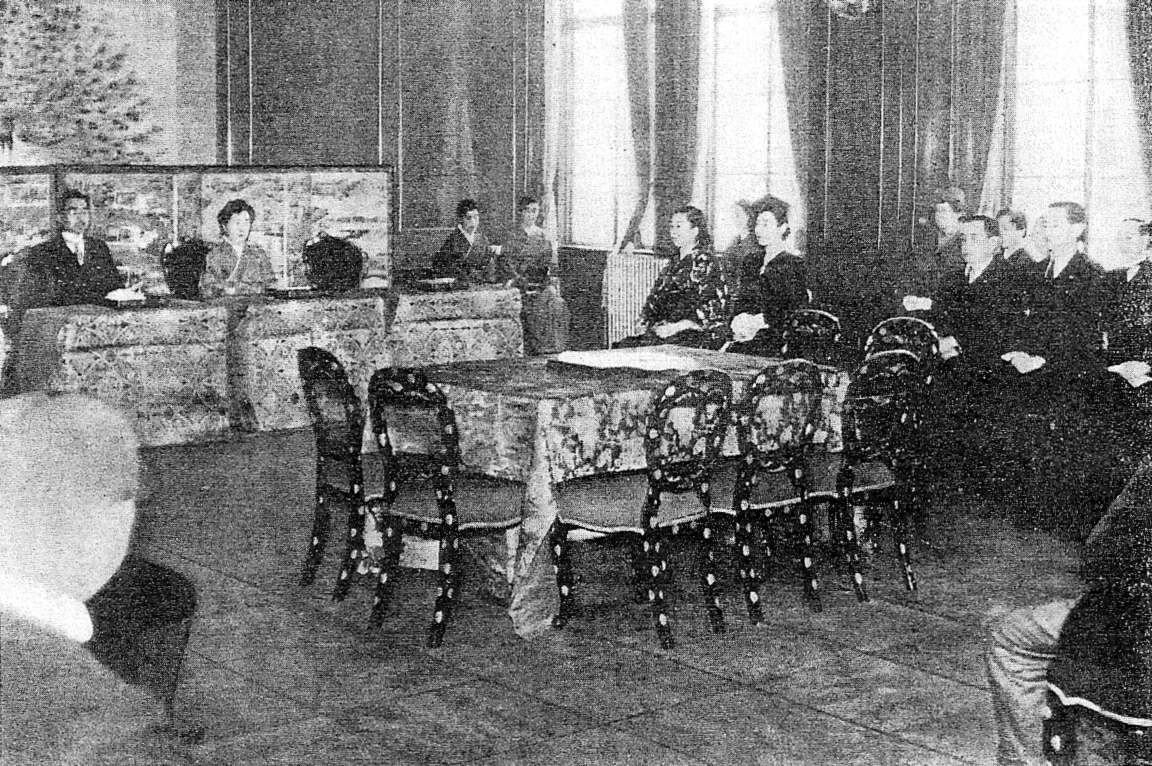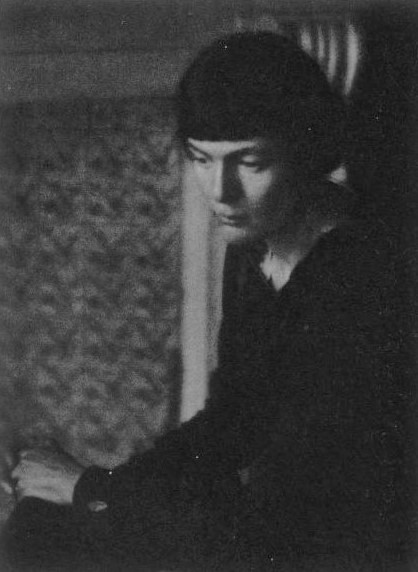|
Cinquain
Cinquain is a class of poetic forms that employ a 5-line pattern. Earlier used to describe any five-line form, it now refers to one of several forms that are defined by specific rules and guidelines. American cinquain The modern form, known as American cinquain inspired by Japanese haiku and tanka, is akin in spirit to that of the Imagists. In her 1915 collection titled ''Verse'', published a year after her death, Adelaide Crapsey included 28 cinquains. Crapsey's American Cinquain form developed in two stages. The first, fundamental form is a stanza of five lines of accentual verse, in which the lines comprise, in order, 1, 2, 3, 4, and 1 stresses. Then Crapsey decided to make the criterion a stanza of five lines of accentual-syllabic verse, in which the lines comprise, in order, 1, 2, 3, 4, and 1 stresses and 2, 4, 6, 8, and 2 syllables. Iambic feet were meant to be the standard for the cinquain, which made the dual criteria match perfectly. Some resource materials define classic ... [...More Info...] [...Related Items...] OR: [Wikipedia] [Google] [Baidu] |
Adelaide Crapsey
Adelaide Crapsey (September 9, 1878 – October 8, 1914) was an American poet. She was born in Brooklyn, New York, and raised in Rochester, New York. Her parents were the businesswoman Adelaide T. Crapsey and the Episcopal priest Algernon Sidney Crapsey, who moved from New York City to Rochester. Early life Adelaide Crapsey was born on September 9, 1878, in Brooklyn Heights, New York. Her parents were Algernon Sidney Crapsey (1847–1927) and Adelaide (Trowbridge) Crapsey (1855–1950). She was their third child, after her brother, Philip, and her sister, Emily. Adelaide was baptized on November 1, 1878, in Trinity Church in New York City, where her father was an assistant minister. Before Adelaide was a year old, her father had become the rector of St. Andrew's Episcopal Church in Rochester, N. Y. His family followed him to Rochester from New York City on the canal boat. In Rochester, Adelaide attended the public schools. Higher education Crapsey was "raised in a liberal en ... [...More Info...] [...Related Items...] OR: [Wikipedia] [Google] [Baidu] |
William Soutar
William Soutar (28 April 1898 – 15 October 1943) was a Scottish poet and diarist who wrote in English and in Braid Scots. He is known best for his epigrams. Life and works William Soutar was born on 28 April 1898 on South Inch Terrace in Perth, Scotland, the only child of John Soutar (1871–1958), master joiner, and his wife, Margaret Smith (1870–1954), who wrote poetry. His parents belonged to the United Free Church of Scotland. He was educated at Southern District School, Perth, and at Perth Academy, before joining the wartime Royal Navy in 1916. By the time he was demobilized in November 1918, he was suffering from what would be diagnosed in 1924 as ankylosing spondylitis, a form of chronic inflammatory arthritis. Soutar began to study medicine at the University of Edinburgh in 1919, but switched to English. He did not excel academically, but began to contribute to the student magazine. His first volume, ''Gleanings by an Undergraduate'' (1923), appeared at his fathe ... [...More Info...] [...Related Items...] OR: [Wikipedia] [Google] [Baidu] |
Lanterne (poem)
A lanterne is a cinquain form of poetry, in which the first line has one syllable and each subsequent line increases in length by one syllable, except for the final line that concludes the poem with one syllable. Its name derives from the lantern shape that appears when the poem is aligned to the center of the page. Each line of the lanterne is able to stand on its own, and while the poem may or may not be given a title, the title of a lanterne sometimes functions as an integral part of the poem, working as a 'sixth' line. See also Concrete Poetry Concrete poetry is an arrangement of linguistic elements in which the typographical effect is more important in conveying meaning than verbal significance. It is sometimes referred to as visual poetry, a term that has now developed a distinct mea ... / i.e. Shape poems References External linksExamples of lanterne poetic form Stanzaic form Graphic poetry Poetic forms {{poetry-stub ... [...More Info...] [...Related Items...] OR: [Wikipedia] [Google] [Baidu] |
Quintain (poetry)
A quintain or pentastich is any poetic form containing five lines. Examples include the tanka, the cinquain, the quintilla, Shakespeare's Sonnet 99, and the limerick. Examples Sonnet 99 (first stanza) The forward violet thus did I chide: Sweet thief, whence didst thou steal thy sweet that smells If not from my love’s breath? The purple pride Which on thy soft cheek for complexion dwells, In my love’s veins thou hast too grossly dyed. — William Shakespeare Autumn Song Know'st thou not at the fall of the leaf How the heart feels a languid grief Laid on it for a covering, And how sleep seems a goodly thing In Autumn at the fall of the leaf? And how the swift beat of the brain Falters because it is in vain, In Autumn at the fall of the leaf Knowest thou not? and how the chief Of joys seems—not to suffer pain? Know'st thou not at the fall of the leaf How the soul feels like a dried sheaf Bound up at length fo ... [...More Info...] [...Related Items...] OR: [Wikipedia] [Google] [Baidu] |
Poetry
Poetry (derived from the Greek '' poiesis'', "making"), also called verse, is a form of literature that uses aesthetic and often rhythmic qualities of language − such as phonaesthetics, sound symbolism, and metre − to evoke meanings in addition to, or in place of, a prosaic ostensible meaning. A poem is a literary composition, written by a poet, using this principle. Poetry has a long and varied history, evolving differentially across the globe. It dates back at least to prehistoric times with hunting poetry in Africa and to panegyric and elegiac court poetry of the empires of the Nile, Niger, and Volta River valleys. Some of the earliest written poetry in Africa occurs among the Pyramid Texts written during the 25th century BCE. The earliest surviving Western Asian epic poetry, the '' Epic of Gilgamesh'', was written in Sumerian. Early poems in the Eurasian continent evolved from folk songs such as the Chinese ''Shijing'', as well as religious hymns (the Sanskr ... [...More Info...] [...Related Items...] OR: [Wikipedia] [Google] [Baidu] |
Haiku
is a type of short form poetry originally from Japan. Traditional Japanese haiku consist of three phrases that contain a ''kireji'', or "cutting word", 17 ''On (Japanese prosody), on'' (phonetic units similar to syllables) in a 5, 7, 5 pattern, and a ''kigo'', or seasonal reference. Similar poems that do not adhere to these rules are generally classified as ''senryū''. Haiku originated as an opening part of a larger Japanese poem called renga. These haiku written as an opening stanza were known as ''hokku'' and over time they began to be written as stand-alone poems. Haiku was given its current name by the Japanese writer Masaoka Shiki at the end of the 19th century. Originally from Japan, haiku today are written by authors worldwide. Haiku in English and Haiku in languages other than Japanese, haiku in other languages have different styles and traditions while still incorporating aspects of the traditional haiku form. Non-Japanese haiku vary widely on how closely they follow ... [...More Info...] [...Related Items...] OR: [Wikipedia] [Google] [Baidu] |
Tanka
is a genre of classical Japanese poetry and one of the major genres of Japanese literature. Etymology Originally, in the time of the ''Man'yōshū'' (latter half of the eighth century AD), the term ''tanka'' was used to distinguish "short poems" from the longer . In the ninth and tenth centuries, however, notably with the compilation of the '' Kokinshū'', the short poem became the dominant form of poetry in Japan, and the originally general word ''waka'' became the standard name for this form. Japanese poet and critic Masaoka Shiki revived the term ''tanka'' in the early twentieth century for his statement that ''waka should be renewed and modernized''. '' Haiku'' is also a term of his invention, used for his revision of standalone hokku, with the same idea. Form Tanka consist of five units (often treated as separate lines when romanized or translated) usually with the following pattern of '' on'' (often treated as, roughly, the number of syllables per unit or line): :5-7-5 ... [...More Info...] [...Related Items...] OR: [Wikipedia] [Google] [Baidu] |
Imagism
Imagism was a movement in early-20th-century Anglo-American poetry that favored precision of imagery and clear, sharp language. It is considered to be the first organized literary modernism, modernist literary movement in the English language. Imagism is sometimes viewed as "a succession of creative moments" rather than a continuous or sustained period of development. The French academic René Taupin remarked that "it is more accurate to consider Imagism not as a doctrine, nor even as a poetic school, but as the association of a few poets who were for a certain time in agreement on a small number of important principles".Taupin, René (1929). ''L'Influence du symbolism francais sur la poesie Americaine (de 1910 a 1920)''. Paris: Champion. Translation (1985) by William Pratt and Anne Rich. New York: AMS. The Imagists rejected the sentiment and discursiveness typical of Romantic poetry, Romantic and Victorian literature#Poetry, Victorian poetry. In contrast to the contemporary G ... [...More Info...] [...Related Items...] OR: [Wikipedia] [Google] [Baidu] |
Stress (linguistics)
In linguistics, and particularly phonology, stress or accent is the relative emphasis or prominence given to a certain syllable in a word or to a certain word in a phrase or sentence. That emphasis is typically caused by such properties as increased loudness and vowel length, full articulation of the vowel, and changes in tone. The terms ''stress'' and ''accent'' are often used synonymously in that context but are sometimes distinguished. For example, when emphasis is produced through pitch alone, it is called '' pitch accent'', and when produced through length alone, it is called ''quantitative accent''. When caused by a combination of various intensified properties, it is called ''stress accent'' or ''dynamic accent''; English uses what is called ''variable stress accent''. Since stress can be realised through a wide range of phonetic properties, such as loudness, vowel length, and pitch (which are also used for other linguistic functions), it is difficult to define ... [...More Info...] [...Related Items...] OR: [Wikipedia] [Google] [Baidu] |
Junie B
Junie is a given name and nickname. Notable people with the given name include: * Junie B. Jones, fictional character in a children's series written by Barbara Park * Junie Cobb (1896–1970), American jazz multi-instrumentalist and bandleader *Junie Donlavey (born 1924), former NASCAR Sprint Cup Series car owner with a team based in Richmond *Junie Hoang (born 1971), plaintiff in '' Hoang v. Amazon.com, Inc.'' * Junie Mitchum (born 1973), West Indies cricketer *Junie Morosi (born 1933), Australian businesswoman Notable people with the nickname include: *Walter "Junie" Morrison (1954–2017), American funk musician * Maia Wright, Swedish singer also known as Junie See also *'' Junie 5'', 1981 solo album recorded by multi-instrumentalist Walter "Junie" Morrison *''Tell Me That You Love Me, Junie Moon ''Tell Me That You Love Me, Junie Moon'' is a 1970 American comedy-drama film directed and produced by Otto Preminger. The film is based on the 1968 novel of the same name by Marjo ... [...More Info...] [...Related Items...] OR: [Wikipedia] [Google] [Baidu] |
PBS Kids
PBS Kids is the brand for most of the children's programming aired by the Public Broadcasting Service ( PBS) in the United States. Some public television children's programs are not produced by PBS member stations or transmitted by PBS. Instead, they are produced by independent public television distributors such as American Public Television, and are not labeled as "PBS Kids" programming, as it is mainly a programming block branding. The target audience is children between the ages of 2 and 8. The network is also available in sub-Saharan Africa and Australia. History PTV block PBS had historically aired programs for children such as '' Sesame Street'', '' Mister Rogers' Neighborhood'', and '' Reading Rainbow''; prior to 1993, these programs aired under general PBS branding. In August 1993, PBS introduced new branding for their children's programs featuring "The P-Pals", animated characters shaped like PBS logos who encouraged skills such as gathering information, self-e ... [...More Info...] [...Related Items...] OR: [Wikipedia] [Google] [Baidu] |
Gerund
In linguistics, a gerund ( abbreviated ) is any of various nonfinite verb forms in various languages; most often, but not exclusively, one that functions as a noun. In English, it has the properties of both verb and noun, such as being modifiable by an adverb and being able to take a direct object. The term "''-ing'' form" is often used in English to refer to the gerund specifically. Traditional grammar makes a distinction within ''-ing'' forms between present participles and gerunds, a distinction that is not observed in such modern grammars as '' A Comprehensive Grammar of the English Language'' and '' The Cambridge Grammar of the English Language''. Traditional use The Latin gerund, in a restricted set of syntactic contexts, denotes the sense of the verb in isolation after certain prepositions, and in certain uses of the genitive, dative, and ablative cases. It is very rarely combined with dependent sentence elements such as object. To express such concepts, the const ... [...More Info...] [...Related Items...] OR: [Wikipedia] [Google] [Baidu] |


.jpg)


